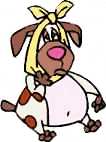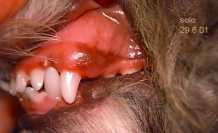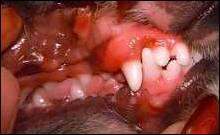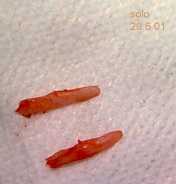|
Ongoing problems are caused by leaving temporary teeth alongside adult teeth.
The temporary teeth in a dog are replaced by the permanent teeth between 4 and 7 months of age. As the permanent tooth grows, its root lengthens and its
crown pushes on the root of the temporary tooth. The ligaments supporting the temporary tooth are weakened and pressure from the surrounding teeth and diet, dislodge the temporary teeth from the mouth.
But in quite a few cases, as we have seen with Löwchens this doesn't happen
and the temporary and permanent teeth are found retained alongside one another. The adult tooth may only weaken a small area of the temporary tooth
ligament and glance off to one side. Puppies so affected may eat a little less than normal and have sore, inflamed or mildly swollen gums. Retained
temporary teeth promote food debris building up between the two teeth and this can cause
advanced periodontal and gum disease, as well as causing an incorrect or uneven bite.
Where there are two teeth sharing the same socket they are also sharing the
ligament system which holds them in the mouth (much like Siamese twins). If
the permanent tooth is fully erupted before the extraction surgery, part of
this ligament system is removed with the temporary tooth when extracted. This
leads to a much weaker adult tooth, more susceptible to infection and eventually loss from the mouth.
All pups should have a dental examination at 6 to 8 weeks of age to assess the bite and at 5 to 6 months of age to re-assess the bite and check for
possible 'retained temporary teeth'. If temporary teeth are retained, the puppy needs them removed in order to avoid further problems. If teeth are
crooked or the bite is uneven then orthodontic treatment may be required to
provide a pain free and functional bite. Any orthodontic adjustment, whether
of genetic origin or not, should be thoroughly discussed before any dental work is completed and should not be performed for cosmetic
reasons.
Permanent teeth can be deviated out of normal position when the temporary teeth are retained. E.g. Lance canines, reverse scissor bite of the incisors,
lower canines ulcerating the roof of the mouth. There can also be a domino effect seen with retained upper temporary canines. The adult upper canine
must erupt forward of the temporary tooth. This means the adult canine is much closer than normal to the third incisor. The lower adult canine would
normally fill the space between the upper third incisor and the upper canine.
This may not be possible if there is less space. The lower canine must continue to erupt and therefore the crown of this tooth is often found on the
inside of the upper canine in the roof of the mouth, when the jaws are shut.
This produces the painful base narrow canine problem, which if not corrected
can cause behavioural changes and nasal infections.
If you see a retained temporary tooth alongside an emerging adult crown, it
is suggested waiting only 5 to 7 days for the temporary to fall out. If by that time the temporary tooth is not loose, then rather than waiting or
trying to loosen it, immediate extraction is advised. Further study has shown that even at 6 months of age the retained temporary tooth may still
have a substantial root, even if they move a little when touched. What has happened is that part of the temporary tooth, where the crown meets the root
has dissolved. Feeding bones or 'wobbling' the tooth will only fracture away
the crown, leaving the root. This can lead to infection in the local area, which will damage the enamel of the emerging adult tooth. The presence of a
root tip will prevent an adult tooth from moving back into the proper position, so you will still be left with a bite problem.
If there has been a retained tooth present for more than 2 weeks after the adult has erupted and suddenly it is lost, then keep an eye on the gum where
the tooth was.
If the root has been completely dissolved or lost with the crown, the gum will heal in 24 hours. If there is an ulcer still present after this time,
then the root remains and needs to be surgically removed for the same reason
as above. This is the problem we have seen most recently in the Löwchens.
A safe rule is that no two teeth (deciduous and adult) of the same type should be in the same place at the same time. Unless they are extremely
loose, retained temporary teeth should be extracted as soon as possible after
the adult tooth starts to erupt. Encourage your veterinarian to keep the extracted temporary teeth to examine the long roots or take an X-ray to confirm there is no retained root present, which may stop the adult tooth
moving back into position. The earlier retained teeth are removed, the fewer
bite and infection problems there will be.
Article written and
photographs supplied by Dr.
Elizabeth-Jo Vickridge BVMS MACVSc (Vet Dentistry) Perth, Western
Australia.
(Email: ejvetdent@aol.com
) |
|
|
|

*The following photo's are of my
"Solo" who Dr. Vickridge had been checking every couple of weeks
as his adult teeth were coming through. The temporary teeth had actually
fallen out but the roots (invisible to the human eye) were retained. The
length of the roots Dr. Vickridge extracted were approximately half the
length of a common paper clip.
*It is perfectly normal for young dogs to lose their deciduous, or "baby," teeth much as human children do. Canines have 28 deciduous teeth and 42 permanent teeth.
The small teeth in the front of a dog's mouth are the incisors; there are six on the top and six on the bottom. Canines, the sharp "fanglike" teeth, total four; two on top (one to each side of the set of incisors) and two on the bottom. Located to the side of the canine teeth, the 12
deciduous premolars will be replaced by 16 permanent teeth. Molars are the teeth located farthest back in the mouth; they are part of the permanent set of teeth only and there are ten of them.
A dog’s health can suffer if their teeth or gums are giving them trouble. Dental exercise (raw beef bones, chew
bars etc.), a balanced diet and teeth cleaning with a canine toothbrush and paste are helpful in keeping your dog’s teeth healthy. An oral check, on a regular basis is worthwhile. Lift the lips well back and inspect the teeth and gums. Any sign of tartar deposits on teeth, discoloured or sensitive teeth or inflamed gums should be checked out. Your dog may need their teeth cleaned or extractions performed if a tooth is badly infected.
Click
HERE to view Canine Dental Chart

CARING FOR YOUR
LÖWCHEN'S TEETH
Dental hygiene is often ignored in the dog. The outcome? Consider what your teeth might look and feel like after months, years or even a lifetime of neglect. They would be a wreck, and you would be miserable. Yes, canine teeth also need frequent brushing to prevent gum disease and early tooth loss, as well as just plain foul breath.
Despite the popular conception, dog biscuits and bones do not keep the teeth clean and healthy. Although some veterinarians feel that gnawing on these hard substances has benefit, it does not prevent the
build-up of plaque and tartar which, unless removed, can lead to gum inflammation, tooth root abscesses and other oral problems. That's the simple truth.
The teeth should be brushed at least once or twice a week, more often if possible. As with grooming, acclimation is best started early in the puppy's life.
To make a toothbrush, fold a square gauze pad loosely around the tip of your index finger. Or you can use a small, soft child's toothbrush or buy a special toothbrush from a veterinarian. Dip the toothbrush or gauze pad in a toothpaste designed for dogs (not for humans, since human formulations can upset the dog's stomach) or into a paste made of baking soda and water. Next, vigorously scrub the outside surfaces of the teeth, especially the rear teeth. With the gauze pad, you may also try to gently massage the gums. It is not necessary to brush the interior surfaces of the teeth.
Your veterinarian should check your dog's mouth for tooth or gum disease during annual checkups. The most common problem, tartar accumulation, resembles yellow or brown cement deposits along the
gum line or in the crevices of the teeth. Despite your best efforts, a proper dental cleaning under general
anaesthesia may need to be performed periodically in a veterinarian's office. |
|

Canine Teeth ::
Page 2 :: Page
3 :: Page 4 ::
Click here to see the
article Selected Canine Malocclusions
Click
HERE to view Canine Dental Chart

| Retained Deciduous Teeth | Caring
For Your Löwchens Teeth | Dog Dental Facts|
| Types of Teeth | Canine
Malocclusions | Estimating Age in the Canine |
| Abnormalities of the Canine Mouth
| Dental Chart | Canine Dental Links |

|
|





